While beautiful, identifying flowers can be challenging. You may think you have spotted the well-known rose, only for it to turn out to be a completely different flower altogether. In this article, let’s dive into a world of flowers that look just like roses, but are not! In fact, while some of these flowers can fool you with their rose-like charm, they may even belong to entirely different botanical families!
But First, What Are Roses?
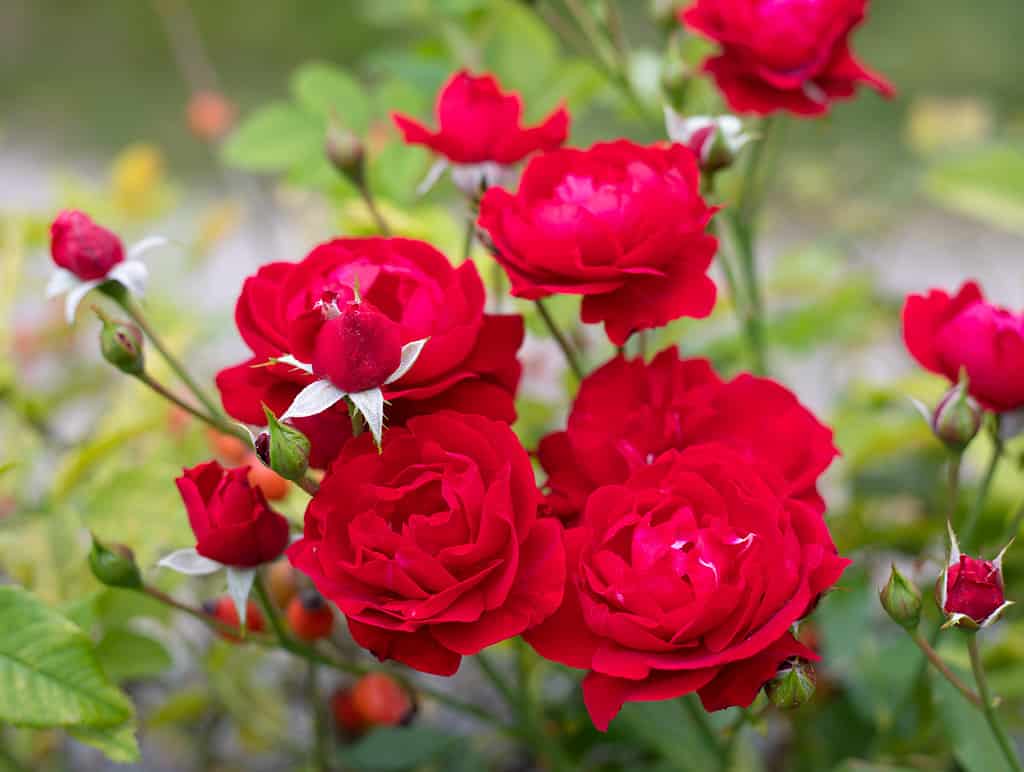
Roses are gorgeous flowers that smell sweet.
©Maria Rzeszotarska/iStock via Getty Images
One of the most famous flowers in the world is the rose, also called the Rosa. The rose is world-renowned for its beauty and elegance and is a favorite flower for many. Cultivated for many thousands of years, there are many, many varieties of roses that come in a huge range of colors, including red, pink, yellow, orange, purple, white, and even black! The gorgeous petals of the rose are incredibly soft and velvety to the touch.
While the petals may differ according to the type of rose, one thing most varieties have in common is the fragrance. In fact, the smell of roses is so captivating that it is a common scent for perfumes as well.
Now, without further ado, here are 11 flowers that look like roses, plus how to identify each one!
1. Dahlia (Dahlia pinnata)

One of the flowers that looks like roses is the dahlia.
©Olga Vasilek/Shutterstock.com
The dahlia often resembles the iconic rose due to its intricate petal arrangements and captivating appearance. Native to the highland regions of Mexico and Central America, the dahlia boasts diverse forms and colors. Its blooms range from simple, single-flowered types to complex, multi-layered double flowers reminiscent of roses. The hues range from the purest whites and softest yellows to fiery reds, deep purples, and pretty much every shade you could think of.
In size, dahlia flowers can vary considerably based on the cultivar. While some petite varieties produce blooms barely 2 inches in diameter, the grander “dinner plate” dahlias can showcase flowers that reach up to 12 inches across. Depending on the type, the plants can stand as short as a foot or grow upwards of 6 feet tall. Preferring well-drained, moderately fertile soil, dahlias thrive in locations with full sun. Given their origin in elevated terrains, dahlias appreciate cooler night temperatures and are often cultivated as annuals in regions with colder winters or as perennials in milder climates.
How to Identify Dahlias
A feature that sets the dahlia and rose apart is that roses typically have a singular, iconic central spiral of tightly packed petals. In contrast, dahlias often exhibit multiple layers of petals radiating from their center in a more uniform pattern. The leaves of the two plants differ as well, with roses having serrated and often glossy leaves, while dahlias usually possess pinnate leaves with a matte texture. Finally, unlike roses, dahlias don’t have thorns on the stems, making them much safer to handle.
2. Peonies (Paeonia)

Many people confuse peonies for roses as the flowers look very similar.
©Fusionstudio/Shutterstock.com
The peony is a perennial plant often hailed for its large blooms that can also be reminiscent of the classic rose. Originating from Asia, Europe, and Western North America, peonies have captured the hearts of gardeners and flower enthusiasts alike for centuries. The blooms can vary from simple, single flowers to double blossoms overflowing with layers of petals. The color palette of peonies spans a captivating range, including whites, pinks, reds, and even yellows, depending on the variety.
The plant’s stature can vary as well, usually between 1.5 to 4 feet tall, though some tree peonies can grow even taller (5 feet). Generally, peonies prefer temperate and cooler climates and thrive best in well-draining soil that receives ample sunlight.
How to Identify Peonies
Roses and peonies have distinguishable features. Roses usually feature a spiral of petals that unfolds layer by layer. In contrast, peonies generally have a more rounded shape, with petals that tend to burst outward in a fuller, more voluminous, and fluffier manner. The texture of peony petals is often softer and more translucent than those of roses as well. Additionally, while both flowers come in various hues, peonies do not naturally come in the deep, true blue or black shades that some roses might exhibit. The leaves of the two plants are also different. Roses possess serrated edges, while peony leaves are broader with a more matte finish.
3. Tulip (Tulipa)
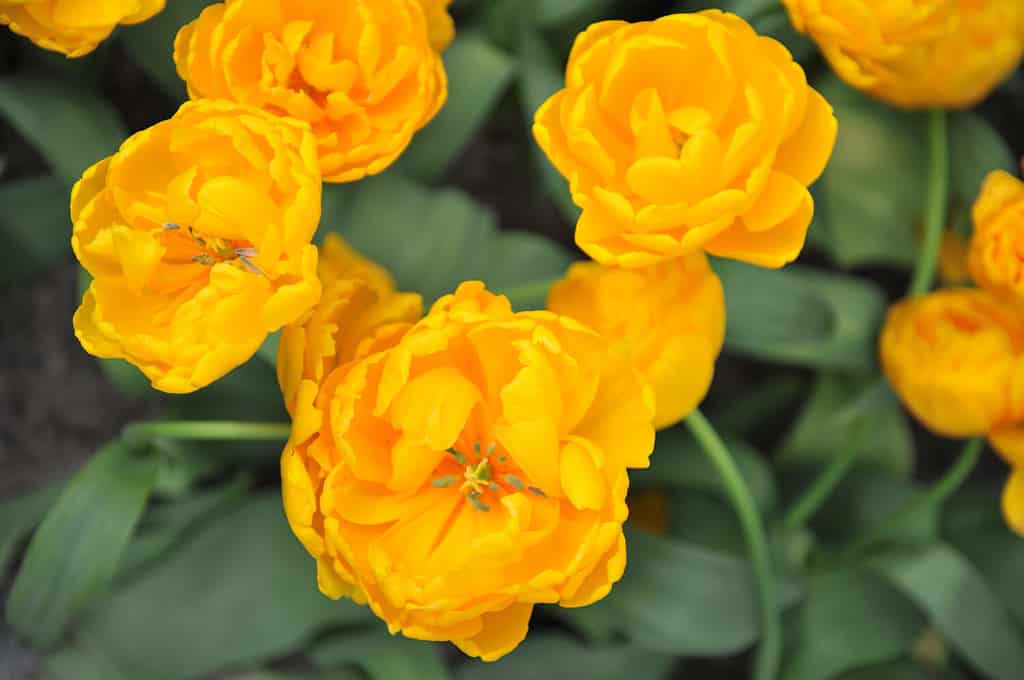
Double tulips look like roses at first glance.
©Sergey V Kalyakin/Shutterstock.com
The tulip is one of the world’s most recognized and adored flowers, belonging to the lily family. Native to Central Asia and subsequently popularized in the Ottoman Empire and the Netherlands, tulips have a rich history. At first glance, certain tulip varieties, especially the double or parrot tulips with their layered petals, may resemble roses. However, the standard tulip form is sleek and bell-shaped, with a more streamlined appearance comprising three petals and three sepals that look like petals, forming a flower with six “petals.” The colors of tulips are vast and varied, covering almost every shade imaginable, from white to deep purple.
A typical tulip bloom measures approximately 2 to 4 inches long, perched atop a slender, green stem that can stand anywhere from 4 inches to 2 feet tall. These flowers require winter chill to bloom successfully, so they thrive in regions with cold winters and are often grown as spring-blooming perennials in such areas.
How to Identify Tulips
Tulips typically have a sleek, bell-shaped silhouette and have smooth, elongated petals that form a bulbous bloom. On the other hand, roses are known for their intricate, layered petal arrangement, often including a central spiral. Tulips usually have a singular, unbranched stem with few leaves, while roses often display multiple leaves along a thorned stem.
4. Carnation (Dianthus caryophyllus)
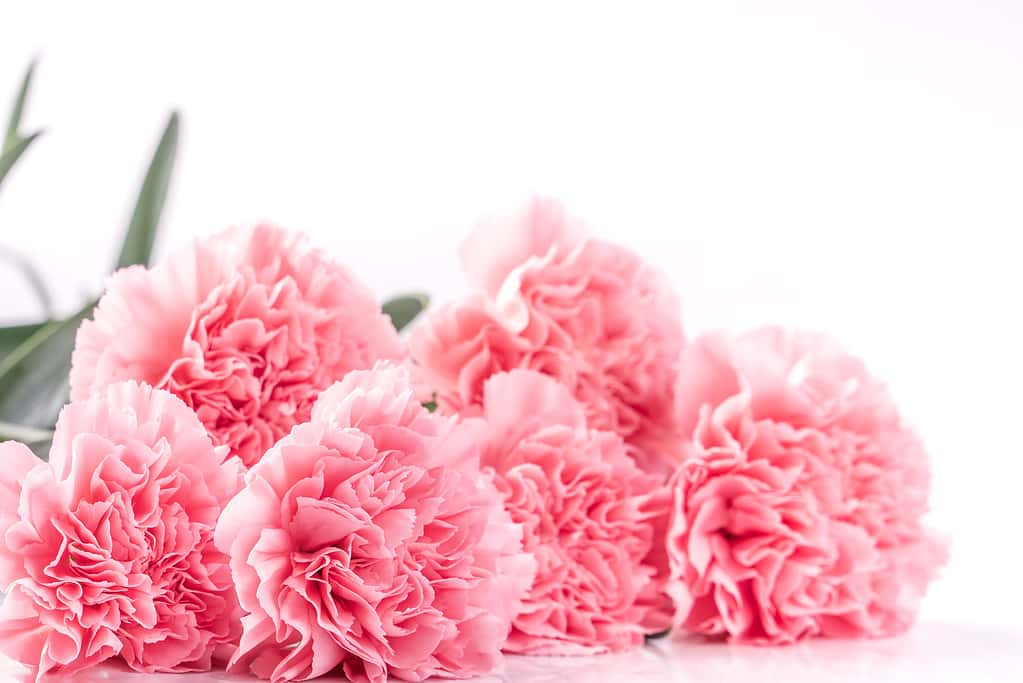
Due to its layered petal form, the carnation is another popular flower that looks like a rose.
©insjoy/iStock via Getty Images
Carnations are one of the world’s oldest cultivated flowers, with records of their use dating back over 1,000 years. These flowers are widely cherished for their ruffled appearance, sweet clove-like scent, and vibrant colors. While roses are renowned for their layered petals, carnations have a more ragged, serrated petal edge, which gives them a unique texture and fluffiness. When fully bloomed, the dense-packed petals of certain carnation varieties can mimic a rose’s appearance. The color spectrum of carnations is diverse, from white and pink to red, with some types even flaunting two-toned petals.
Carnation blooms sit atop a long, slender, and straight stem, which can reach heights of 18 to 30 inches. These flowers are native to the Mediterranean region but have been cultivated in various climates worldwide due to their adaptability and popularity. Preferring full sunlight and well-draining soil, carnations are pretty cold-hardy, though they flourish in milder climates.
How to Identify Carnations
Observing the differences in petal structure, stem features, and scent can help distinguish between a rose and a carnation. Carnations have ruffled, serrated petal edges and a denser, puffier appearance. Additionally, the stem of a rose often features thorns, while carnation stems are typically smooth. The fragrance also sets them apart; roses have a signature sweet scent, whereas carnations often have a spicy, clove-like aroma.
5. Gardenia (Gardenia)
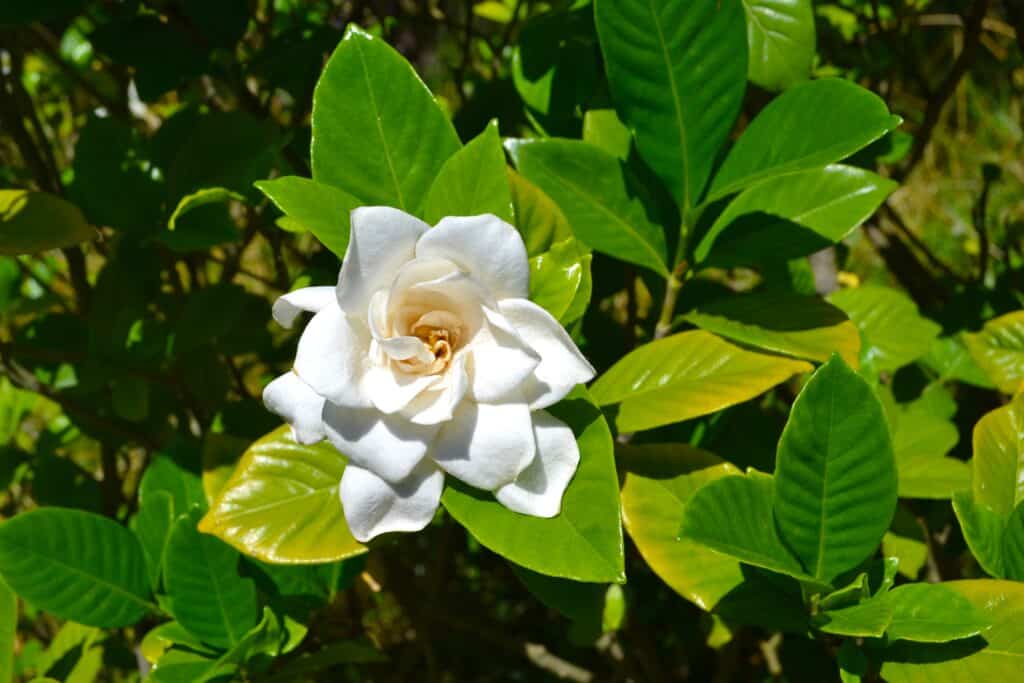
Just like roses, gardenias have a pronounced fragrance, though they do boast a stronger scent!
©NADII_art/Shutterstock.com
Native to the tropical and subtropical regions of Africa, southern Asia, Australasia, and Oceania, gardenias are unmistakably recognized for their waxy, pure white or pale-yellow blossoms. Their petals are soft, often layered in a way that may remind you of roses, especially in double-flowered varieties. The pronounced fragrance of the gardenia is a standout, richly sweet, and heavy, making it a favored choice for perfumes – just like roses!
Size-wise, individual gardenia flowers typically span from 2 to 5 inches in diameter, depending on the specific variety. The shrubs they grow on can reach anywhere from 3 to 8 feet, displaying dark green, glossy leaves that contrast with their blooms. When it comes to habitat, gardenias thrive in warm, humid environments, preferring acidic, well-draining soils and dappled sunlight.
How to Identify Gardenias
Gardenias boast petals arranged in a rosette pattern, typically pure white or yellow. On the other hand, roses have a broader color spectrum and are known for their signature spiraling petals. Another prominent distinction between the two is their scent. Gardenias have a richly sweet and somewhat heavy aroma, while roses offer various fragrances, often described as sweet and subtle. Furthermore, gardenias grow on shrubs with glossy, dark green leaves, whereas roses frequently present thorns on their stems.
6. Ranunculus (Ranunculus)
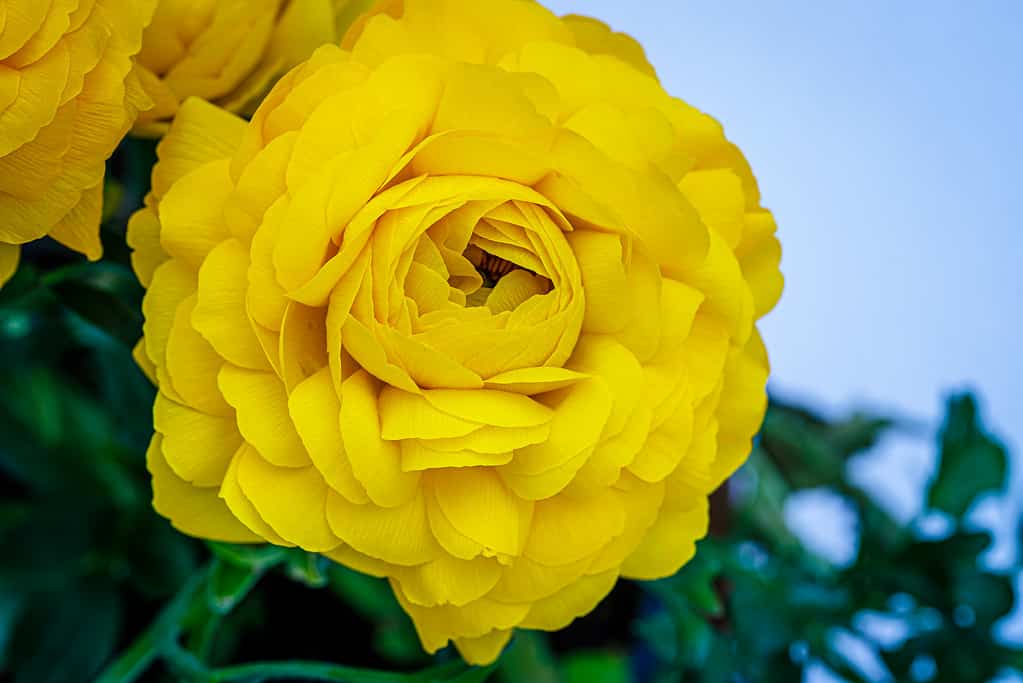
Ranunculus, in particular, the
Ranunculus asiaticus(pictured) looks very similar to a rose.
©nnattalli/Shutterstock.com
Originating from Asia, ranunculus are flowering plants found in meadows, woodlands, and wetlands. Their multi-petaled appearance sets these flowers apart and sometimes can be mistaken for roses, especially in cultivated varieties. Ranunculus petals sit on a slender stem and come in various colors, including yellow, pink, orange, purple, and blue. Ranunculus flowers can range from small to a more substantial, almost rose-like diameter, depending on the specific species. When talking about the similarities between ranunculus and roses, individuals are generally talking about a specific variety: the Persian buttercup (Ranunculus asiaticus),
Cultivated varieties of ranunculus are the ones that most frequently lead to rose comparisons, with their larger size, dense petal arrangement, and diverse color palette. These flowers predominantly thrive in temperate zones and can be found across many habitats, from damp meadows to dry grasslands. They generally prefer full sunlight and well-draining soil.
How to Identify Ranunculus
Ranunculus typically have bright, shiny petals that come in many colors. Roses come in a broader range of colors and have a more robust and rounded bloom. Additionally, the leaves of ranunculus are usually finely divided into many lobes, whereas rose leaves are oval and toothed. The most significant difference between the two is that roses have a pleasant scent while ranunculus flowers are unscented.
7. Camellia (Camellia)

Due to their dense layers of petals, camellias look like roses.
©iStock.com/penkanya
Recognized for their symmetrical blooms, camellias can sometimes be mistaken for roses due to their dense layers of petals and the rounded shape of their flowers. The petals often have a glossy appearance, and the range of colors includes white, pink, red, and even some striped or variegated combinations. Their evergreen leaves add to their appeal, being dark green, glossy, and typically elliptical with serrated edges.
Camellia flowers can vary widely based on the specific variety and species, with diameters ranging from a modest 2 inches to a substantial 5 inches or more. They grow on shrubs ranging from a few feet to over 15 feet tall, though many cultivated varieties are maintained at a more manageable size for garden and ornamental use. Camellias thrive in temperate climates, preferring dappled shade or filtered sunlight, as they can be sensitive to intense direct sun and cold frosts. Rich, well-draining, and slightly acidic soil is ideal for these plants.
How to Identify Camellias
Camellias usually have glossy and waxy leaves, and their flowers often exhibit symmetry in petal arrangement, creating a more uniform appearance. On the other hand, roses display a spiraled collection of petals, opening from a tight central bud. And rose leaves are generally much thinner and more delicate.
8. Begonias (Begonia)
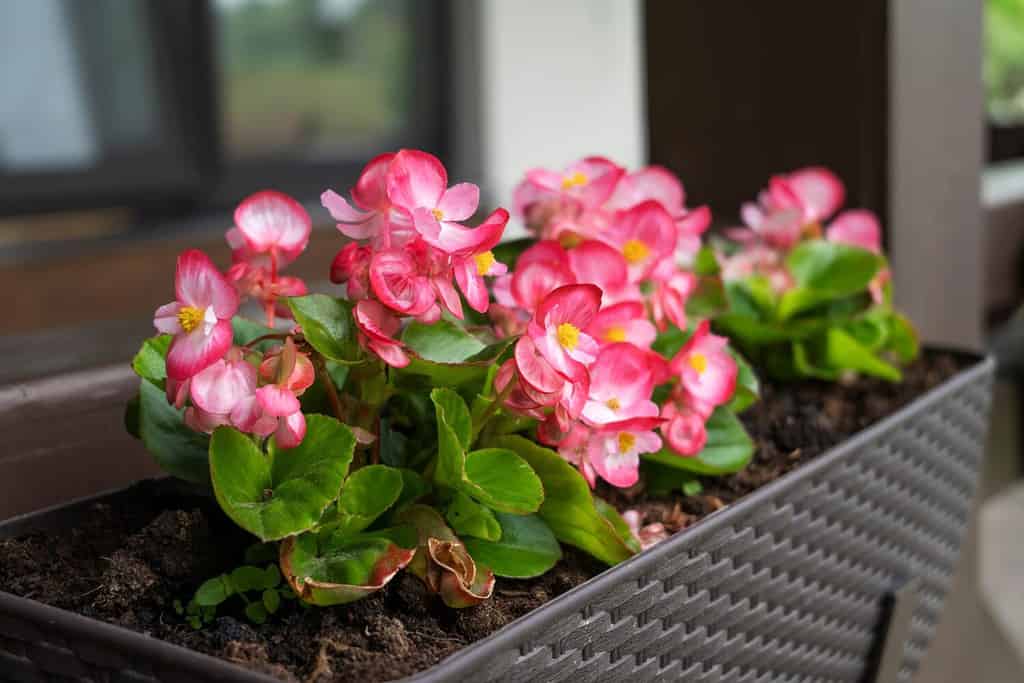
Coming in a wide range of colors, begonia flowers can grow up to several inches across.
©IRINA CHETVERIKOVA/Shutterstock.com
Begonia flowers come in many colors, including white, pink, red, orange, and even yellow. Their petals can range from smooth and glossy to ruffled or toothed, depending on the species. In size, begonias can vary extensively, with flowers ranging from less than an inch to several inches across. As for the plants themselves, they can be compact, trailing, or even reach several feet in height.
Begonias are versatile in habitat preference, thriving in tropical and subtropical environments. While many species favor shaded or semi-shaded areas, certain varieties are well-adapted to more sun-exposed locations. Good drainage is crucial, as begonias can be sensitive to excessive moisture.
How to Identify Begonias
At first glance, the two flowers may look similar. But begonia leaves are varied in shape, often with a succulent texture, and can have unique patterns or colors. In contrast, rose leaves are generally compound with serrated edges and a matte green hue. The growth habit also differs; roses often form woody shrubs or climbers, while begonias can be herbaceous, trailing, or semi-woody. The begonia blooms themselves are generally much smaller than roses.
9. Lisianthus (Eustoma)

Native to the American continent, lisianthus boasts beautiful blooms that come in white, pink, purple, and blue shades.
©AyahCin/Shutterstock.com
Lisianthus is a beautiful flowering plant that often gets mistaken for roses due to its beautiful and multi-petaled blooms. These flowers come in a wide range of colors, including white, pink, purple, and blue. In terms of size, lisianthus flowers typically measure between 2 to 4 inches wide and grow on slender, upright stems. The plants themselves can reach heights of 1 to 3 feet. The lisianthus’s leaves are smooth and gray-green in color.
Lisianthus is a warm-season plant that thrives in full sun and prefers well-drained soil that is slightly acidic. Native to the southern US, northern South America, and Mexico, this flower blooms from early summer to early fall.
How to Identify Lisianthus
While lisianthus flowers may resemble roses at first glance, there are some key differences to help you distinguish between the two. Lisianthus flowers are generally smaller than rose blooms, and they come in fewer variations of color than roses. The lisianthus plant itself is generally shorter than many rose varieties as well. As for the leaves, lisianthus leaves are blue-gray in color and are not serrated, unlike rose leaves.
10. Impatiens (Impatiens)
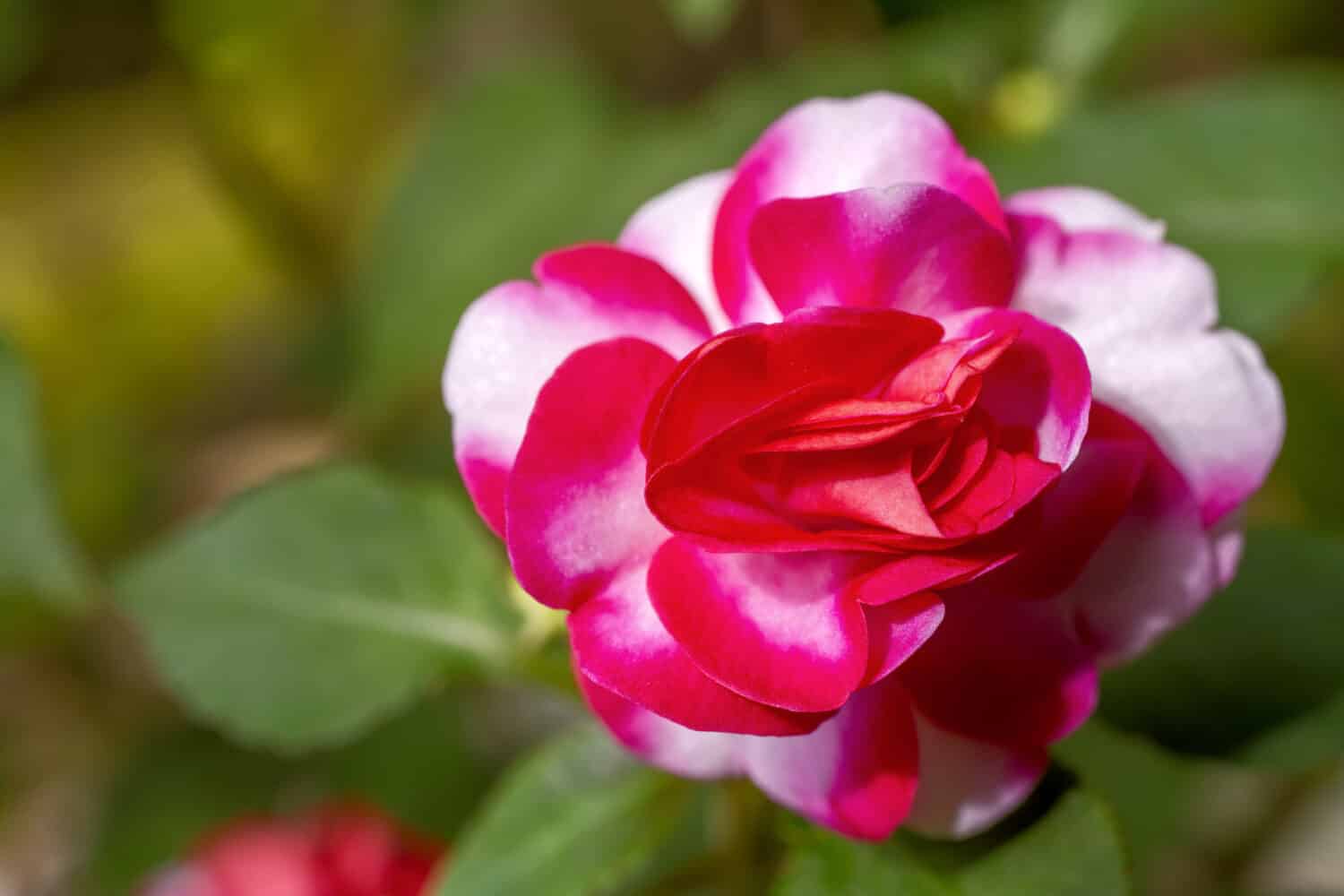
Double impatiens, like the one pictured, can look like roses.
©Varts/Shutterstock.com
Impatiens are popular ornamental plants known for their profusion of colorful flowers and garden versatility. Their blooms can vary in color, including shades of pink, red, purple, white, and orange. While impatiens won’t generally be mistaken for roses, double impatiens can look very similar. At a glance, the flower’s rounded petals might be reminiscent of roses, but upon closer inspection, the differences in form are evident. Impatiens flowers typically have a more elongated center and a flat face, a characteristic that sets them apart from roses’ multi-petaled, layered appearance.
In terms of size, individual impatiens plants often grow to a height of 6 inches to 2 feet, depending on the variety and conditions. They have medium-green leaves that are lance-shaped. Native to the northern hemisphere, impatiens thrive in moist, well-draining soils, making them ideal for shaded and semi-shaded areas in gardens or as container plants.
How to Identify Impatiens
Impatiens have a flat-faced bloom with a more elongated center. While both the rose and impatiens can exhibit a range of vibrant colors, the structure of their flowers is notably different. Additionally, the leaves of a rose are typically larger with a serrated edge, while impatiens possess smooth, lance-shaped leaves. The habitat can also be a clue: roses often prefer sunnier spots, whereas impatiens thrive in shaded to semi-shaded areas.
11. Anemone

With their numerous petals, double anemone flowers can look like roses.
©RaksyBH/Shutterstock.com
Anemones, or more specifically, double anemones, may look like roses at first glance due to their intricate blooms. Just like roses, anemones come in a captivating array of colors, including white, pink, purple, red, and blue. In terms of size, double anemone flowers usually measure around 2 to 3 inches in diameter.
These flowers thrive in well-drained soil, and they prefer full sun to partial shade. Some varieties of anemones are relatively cold-hardy, while others prefer warmer climates. But as a general rule, most anemones will thrive in USDA hardiness zones 4 to 8.
How to Identify Double Anemones
While your average anemone is easily distinguished from a rose, double anemones can be deceiving at first glance. Double anemones, like roses, have multiple layers of petals, giving them a full and lush appearance. However, the petals of double anemones tend to be more delicate, lacking the velvety texture commonly associated with roses. Double anemones also generally have smaller flowers compared to roses. As for the leaves, the leaves of double anemones are typically deeply lobed, with a fern-like appearance. On the other hand, rose leaves are usually oval-shaped with serrated edges.
Summary of Flowers That Look Like Roses and How to Identify Each
| Number | Flower | Botanical Name |
|---|---|---|
| 1 | Dahlia | Dahlia |
| 2 | Peonies | Paeonia |
| 3 | Tulip | Tulipa |
| 4 | Carnation | Dianthus caryophyllus |
| 5 | Gardenia | Gardenia |
| 6 | Ranunculus | Ranunculus |
| 7 | Camellia | Camellia |
| 8 | Begonia | Begonia |
| 9 | Lisianthus | Eustoma |
| 10 | Impatiens | Impatiens |
| 11 | Anemone | Anemone |
The photo featured at the top of this post is © Varts/Shutterstock.com
Thank you for reading! Have some feedback for us? Contact the AZ Animals editorial team.







